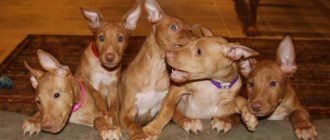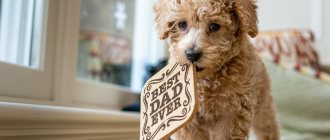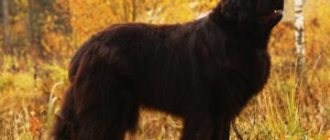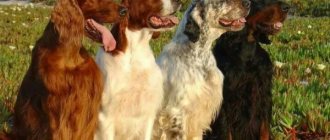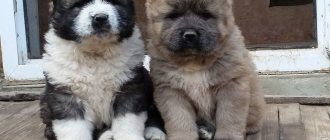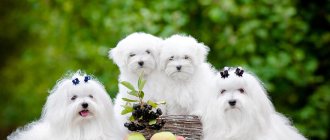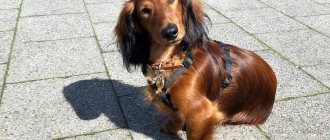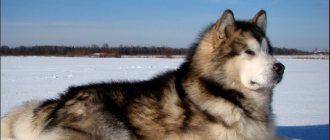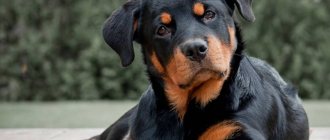| Intelligence: |
| Aggressiveness: |
| For security: |
| For children: |
| Training: |
| Difficulty in care: |
The Icelandic dog is rightfully considered the national pride of the Icelanders. The breed belongs to the Spitz family and is distinguished by its special working qualities. Dogs of this breed do not quarrel with others and are especially quick-witted. These dexterous and strong shepherd dogs know how to guard, herd flocks, and even participate in the search for lost sheep. They get along well with small children, replacing parental attention.
Origin
The first breeds of dogs arrived with the settlers. The Icelandic Sheepdog, also known as the herding husky, dates back to the distant 9th century. It is known that its ancestors are the dogs of the Celts and Germans, who settled these territories in the 5th century straight from Ireland and Scotland, and a few years later from Norway. It is worth noting that farming settlements had a different attitude towards Icelandic dogs. Despite their small size and gentle temperament, shepherd dogs were so brave that in the event of an attack by predators, they instantly showed unusual anger, protecting the herd until their last breath.
People could not find better guards, because the dogs not only guarded the sheep, but also accompanied them to the meadows and back to the folds. Dogs lived on the street, but love forced people to consider dogs as full-fledged members of the family.
There have been dangerous moments in the history of the breed. So, during the period of exacerbation of the plague, many dogs could not be saved. It was possible to restore the population through the great efforts of American and Icelandic dog breeders. The dog's distinctive features were officially adopted in 1898 in Denmark and Great Britain. Unfortunately, the species never managed to gain worldwide popularity, since there are only 3.5 thousand animals.
History of the breed
The ancestors of the breed came to Iceland with the Vikings , presumably in the 9th-10th centuries AD. The development of agriculture among the Norwegian peoples contributed to the selection of local dogs, and this is how the first Icelandic Sheepdogs appeared.
The Vikings used them to accompany livestock . The dogs learned to gather the herd, urging the stragglers of the sheep, and direct it in the right direction.
The breed easily got along with people and did not show aggression towards strangers. However, they raised their voices when guests approached the hosts. Such dogs were engaged in herding work in any conditions. Bad weather, mountainous terrain, and the proximity of dense forests did not become an obstacle.
The Vikings valued them for their loyalty, endurance, intelligence and hard work. Their sagas contain references to dogs that are probably Icelandic Sheepdogs.
The British became interested in colorful shepherd dogs, and the Norwegians established a pet trade. Now Icelandic Shepherds lived not only on the lands of peasants, but also on royal estates. It is noteworthy that the great playwright William Shakespeare dedicated a couple of lines in the play “Henry V” to this breed.
“...Ugh, the mongrel is on you. The Icelandic dog is lousy!…”
Henry V, Act 2, Scene 1
The 19th century was a turning point for the breed, because almost the entire population died from the plague . Earlier, in the 18th century, Iceland suffered significantly from earthquakes and volcanic eruptions, which claimed thousands of human and dog lives.
Thanks to the efforts of livestock specialists, together with dog lovers from Iceland and Great Britain, the number was restored. Today there are few Icelandic Sheepdogs in the world.
In 1987, at an exhibition in Copenhagen, the first three representatives made their debut in the ring. A year later, Danish cynologists recognized the breed as independent, and the British translated the standard and registered the name in their lists in 1995.
Ten years ago, experts spoke of 4,000 dogs living in the world, while at the beginning of the last century there were no more than 40.
Body type
The Icelandic dog's build is more elongated than slender. Wide back with well-developed muscles. Withers of uniform shape. The croup is rather short and voluminous, slightly sloping. The ribs are slightly arched, resembling an arch.
The shape of the chest is quite deep and wide, and its front part protrudes slightly above the front legs, while the chest bone does not move forward much.
Wool
Icelandic dogs can have two types of coat - short and long. Each has good density and water resistance. The outer layer is densely planted, straight and may be flat or slightly ruffled. The structure of the undercoat is more delicate and dense. The covering on the paws, ears, muzzle and skull is shorter than on the body. The longest hair covers the hind legs, neck, chest and back. There is also a visible difference between males and females.
Color
The fur of purebred herding huskies is traditionally colored in light shades. The following color combinations may be found:
- White with cream.
- Black and white.
- Gray with white.
- Golden with white.
- Beige with white.
- Chocolate shade with white color.
Breed characteristics
Height at withers: males – 46 cm, females – 42 cm.
Weight: 10-16 kg.
Color: shades of orange, black and tan (tricolor), gray, chocolate brown. White spots of small and medium size on various parts of the body are acceptable. A large amount of white, black back of red dogs, solid black color are considered defects.
Dewclaws: necessarily double, like the fifth toes.
Eye color: dark brown, may be slightly lighter in chocolate-colored dogs. The color of the eyelids and lips is dark brown.
Nose color: black or dark brown with chocolate coat color.
General appearance: dogs of an elongated format with a deep chest, females are more fragile than males. The ears are erect, triangular in shape, the tail is curved in a ring. Energetic and easy movements. The coat is either short or long, but with a thick undercoat. The muzzle is wedge-shaped.
Behavior and temperament
Icelandic dogs are incredibly resilient and proactive . Energetic and strong, the animals are quite suitable as shepherds. It should be noted that this breed is completely unsuitable for hunting. Having a cheerful temperament, dogs always kindly greet guests, flirting a little and not showing a bit of aggression.
The animal has a serene, peaceful and cheerful character. The obedient and affectionate dog easily gets along with other animals and gets along unsurpassedly with small children. If there is no threat to life, they almost never show anger. They quickly get used to people and love being in company. If such a dog is left alone for a long time, he will be very worried.
Health and life expectancy
Icelandic dogs live up to 14-15 years . This is a healthy, long-living breed, which is typical for rare breeds with these dimensions.
From time to time, information appears about cases of hip dysplasia, but even in extreme cases, the course of the disease is not complicated, as in large breeds. Older dogs experience eye problems (inflammation).
Upbringing
Dog breeders note that the animal is particularly sensible and intelligent, so owners do not need to think about special training methods. A course of so-called unified education is quite sufficient training. It is desirable that the course is presented consistently, in a friendly manner, without the use of rude or harsh techniques. Shepherd dogs adapt quite easily and quickly to new conditions, and always try to achieve the favor and love of their owners.
Training
The Icelandic dog's ability to train is at a high level. Representatives of the breed quickly remember commands and happily carry them out.
A dog can be taught tricks that are not part of the general obedience course. Anatomy allows you to move easily, overcome obstacles of various heights, and participate in agility competitions.
Owners of Icelandic Shepherds are often keen on agility and freestyle. Such activities require physical activity and the ability to work with sports equipment.
Content
History has left its mark, making it much more difficult for an Icelandic dog to adapt to urban living conditions. Living in a city apartment does not allow her to use her potential, so the animal begins to experience stress.
But the outdoor working environment and active, constant work are a breath of fresh air for her. For this reason, it is advisable to keep this breed on a farm, a private house, and where it can find free territory and a favorite pastime. If the dog lives in an apartment, it should take walks at least 1.5-3 hours a day.
The Icelandic guard dog is not afraid of precipitation, hot temperatures and frost. Wool protects it in the cold season, and in the summer - from heat and direct ultraviolet rays. In order for the wool to get wet to the skin, you will have to try hard.
Icelandic dog and man
All dogs of this breed are very active . It is not recommended to have them for people who do not like to spend time in the fresh air or long walks. A responsible teenager can handle the role of the owner, but not a child.
Keeping in an urban environment is justified if there are daily long walks so that the dog can run around enough.
A properly raised individual gets along with children and does not hunt cats. Icelandic dogs with a healthy psyche do not show aggression towards people.
The Icelandic dog is a Spitz by origin and a Shepherd by vocation. This means that she can be both a household assistant and just a pet.
Breed photo
Caring for an Icelandic Sheepdog
The Icelandic Shepherd's coat can be short or long, with both lengths having an outer coat and an undercoat. However, its thick double coat requires only minimal grooming. Brush the coat once or twice a week to remove loose fur and prevent matting.
During periods of severe undercoat hair loss - twice a year - it is recommended to brush it more often to remove excess hair. There is no need to bathe the breed often, as the coat is relatively easy to keep clean and healthy with regular brushing. As with other dog breeds, nails should be trimmed every three to four weeks as needed.
Icelandic Shepherds are athletic, active, intelligent and have a lot of energy, so regular exercise is very important. The brains and active nature of herding breeds require a combination of mental and physical exercise to keep the animal on its toes.
To keep your Icelandic Shepherd physically and mentally healthy, try incorporating puzzles, agility, scent work, long exploratory walks, runs, and exercise throughout the dog's life.
Without physical and mental exercise, the breed may act out, become bored, or exhibit other behavioral problems.
Like any dog breed, the Icelandic Shepherd needs proper training with rewards with toys and food, a routine and lots of love.
This breed loves to bark, mostly barking at other animals. They used to warn their owners about danger in the mountains or on open plains - this is normal behavior for this breed.
Like any herding breed, they will chase cars and run after small animals, so you will need to keep the dog on a leash or in a fenced yard in areas where cars frequently pass. Teach your dog to be good at remembering commands at an early age, a skill that will come in handy as your dog gets older.
Overall, the Icelandic Shepherd is very friendly, playful, affectionate, an enthusiastic learner and an excellent companion. However, keep in mind that this breed is very active and its excessive barking may interfere with apartment living.
Feeding
These animals are ready to eat whatever their owner prepares for them. It is important not to give too much food and follow a certain feeding schedule. For an adult, two meals a day is enough. Food should not contain a lot of fat, be balanced, rich in minerals and vitamins.
Veterinarians advise feeding the animal after a walk. The diet should contain by-products, fruits, cereals, meat, vegetables, dairy products and boneless sea fish. After eating, the animal must rest for some time, otherwise intestinal volvulus may occur.
Characteristics of the Icelandic Sheepdog
| Attachment level | High |
| Friendliness | High |
| Child friendly | High |
| Loyalty to other pets | Average |
| Exercise needs | Average |
| Playfulness | High |
| Energy level | High |
| Learning ability | High |
| Intelligence | High |
| Tendency to bark | High |
| Shedding amount | Average |
| Good for novice owners | Short |
| Living in an apartment | Short |
Character
Unpretentious, loyal, playful dogs. Medium active, they love to be around people and are incredibly loyal, making them ideal family dogs.
The downside is that without companionship, they get bored, don't like to be left alone for long periods of time, and need more attention than other dog breeds.
In addition, such sensitivity affects training and one cannot be particularly strict with them.
Training should be consistent, but gentle and begin as early as possible. The Icelandic dog is smart, but matures emotionally later than other breeds.
The puppy's development continues until the second year of life. Proper training and adequate socialization are important for Icelandic watchdogs.
The attachment to people continues and for strangers dogs often greet them as friends. When scared, they growl and simply run away rather than engage in conflict. But usually they just want to make friends and are not well suited for security duty.
Puppies that have been raised without proper socialization may be aggressive towards dogs of the same sex, but they are usually peaceful.
Created for work and accustomed to harsh climates, these dogs suffer from excess energy in apartment conditions. Work is what they need to maintain physical and mental health. Moreover, they are easy to train and love to learn.
Despite their small size, they need space to run and be active and do best in a private home with space for other animals.
They are suitable for active families or singles, those people who want a dog to be their faithful companion and ally. Icelandic Shepherds love water, swimming, and some even try to play with their water bowls.
As a herding dog, the Icelandic often uses its voice. Barking is part of their nature and they successfully express different emotions with them. Take this fact into account, as they may not be very pleasant neighbors.
In addition, these are real escape artists that no fence can stop.
Overall, the Icelandic dog is a sweet and loyal companion who loves making friends and spending time with family. When necessary, she works hard, and when at home, she enjoys socializing. They are ideal for active, curious people living in a private home.

